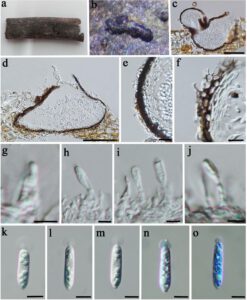Acrocalymma aquatica Huang Zhang & K.D. Hyde, Cryptogr. Mycol. 33(3): 337 (2012)
Index Fungorum number: IF 835894; Facesoffungi number: FoF 07098,
Saprobic on submerged wood in a freshwater stream. Sexual morph: undetermined. Asexual morph: Conidiomata 120–270 μm diam., 110–250 μm high, black, solitary to gregarious, immersed to partly erumpent, pycnidial, globose to subglobose or irregular in shape, unilocular, glabrous, thick-walled, papillate. Ostiole single, centrally located. Conidiomatal wall 12–27 μm wide, composed of thick-walled cells of textura angularis, with brown to dark brown cells in outer several layers, gradually merging with hyaline cells lining the cavity. Conidiophores reduced to conidiogenous cells. Conidiogenous cells 3–10 × 2–5 μm, hyaline, enteroblastic, phialidic, cylindrical to lageniform, determinate, formed from inner layers of conidiomata. Conidia 13–17 × 2–5.5 μm ( ̄x = 15 × 4 μm; n = 30), hyaline, cylindrical to fusiform, with rounded apex and more or less narrow truncate base, straight, unicellular when young, becoming 1–2-euseptate at maturity, not constricted at the septa, thick-walled, smooth-walled, bearing a flabellate, mucoid appendage at the apex.
Material examined – Thailand, Chiang Mai, on submerged wood, 16 November 2010, Huang Zhang d67 (MFLU 11–1113, holotype).

Fig. 1 Acrocalymma aquatica (MFLU 11-1113, holotype). a Herbarium specimen. b Appearance of black conidiomata on the host. c, d Vertical sections of conidiomata. e–f Section of peridium. g–j Conidiogenous cells and developing conidia. k–o Conidia (note k, m from herbarium specimen MFLU 111137). Scale bars d–c = 100 μm, e–f = 10 μm, g–o = 5 μm.
